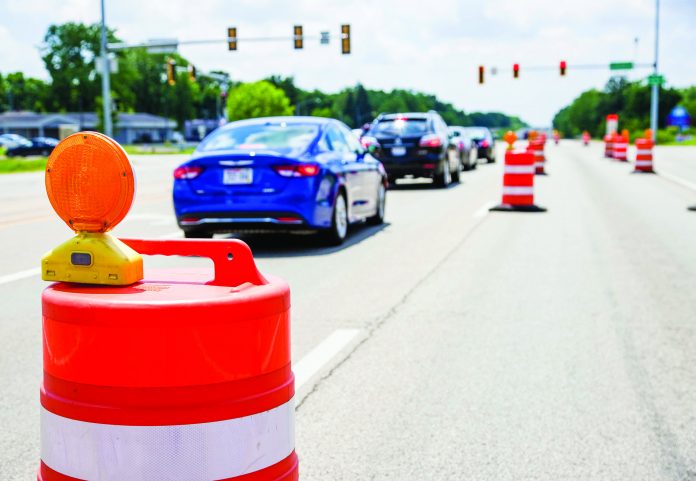A working group to determine options to extend the life of County of San Diego road pavement will continue.
A 5-0 Board of Supervisors vote March 27 received a report from the Building Better Roads working group, accepted the findings, and directed the working group to continue providing potential solutions.
“This working group was a great exercise in collaboration,” said Supervisor Kristin Gaspar. “This is truly something that looks to benefit the entire region long-term.”
The county’s Department of Public Works maintains nearly 2,000 miles of road in unincorporated San Diego County, and road crews inspect the roads and prioritize them for preventative maintenance.
DPW utilizes a pavement management system which incorporates field review, resident and community input, and mechanical test data collection to determine which roads are most in need of resurfacing. The structural deterioration of pavement is measured visually by assessing the degree and type of cracking, the surface deterioration, and surface defects.
The road maintenance program also evaluates the preferred rehabilitation strategy. Asphalt concrete pavement overlays in which two to three inches of new asphalt are laid over deteriorated asphalt roads are used for severely degraded roads with extensive cracking or potholes.
If the road has only minor cracking and no significant surface damage a thinner layer of slurry seals is a less expensive option to extend the pavement life.
The asphalt overlays include reclaimed asphalt pavement material, or old asphalt which was removed from a deteriorated road, ground up, and used as a substitute for new sand and rock which would otherwise have been needed for the new asphalt.
DPW has used both reclaimed asphalt pavement and recycled concrete in road base materials for new road construction.
If a road is in very poor condition DPW will likely use a cold-in-place recycling process.
Several inches of existing asphalt are removed from the road, the removed material is mixed at the project site to make new asphalt, and the new asphalt is then placed on that same road.
The county has also used rubberized asphalt concrete for the top layer in the past. Although rubberized asphalt concrete is approximately ten percent more expensive than ordinary asphalt concrete the rubberized surface has proven to be more durable than normal asphalt concrete. Over the long term asphalt concrete decreases noise by four to six decibels, so the benefit is maximized on roads with high traffic volumes which are close to residential streets.
The other advantage of rubberized asphalt concrete is that it allows former tires to be recycled, and the county’s use of rubberized asphalt concrete has included grant applications to the state Department of Resources Recycling and Recovery to subsidize the cost.
The use of recycled material has benefits other than landfill diversion.
Using recycled asphalt and concrete reduces the need for new material processing and mining locations which also decreases the amount of transportation and manufacturing required for production.
Future potential methods of treating roads including increased use of reclaimed asphalt pavement, cold-in-place recycling, and microsurfacing (which uses a polymer additive) as well as rubberized asphalt.
In September 2018 the Board of Supervisors directed the county’s Chief Administrative Officer to create a working group comprised of industry associations, public agencies, and county staff to identify innovative and cost-effective pavement preservation treatments which can be used on county roads.
The CAO was directed to return to the Board of Supervisors within 180 days based on the working group’s findings.
The working group included representatives from DPW, the California Department of Transportation, and various jurisdictions in the region as well as from private industry. Eleven working group meetings were held between Nov. 17 and Feb. 26, and representatives from nine incorporated cities and the San Diego Association of Governments attended meetings as did representatives from the county, Caltrans, the Associated General Contractors Association of America’s San Diego Chapter, the California Asphalt Pavement Association, the California Construction and Industrial Materials Association, the California Nevada Cement Association, the construction materials education group Project Cornerstone, and various general contractors, specialty pavement contractors, and material suppliers.
The working group formed subcommittees to evaluate specific topics.
The number of cities involved allowed an evaluation of different materials and contracting methods used throughout the region.
The subcommittees determined that efficiencies and cost savings could be gained by exploring four focus areas: asphalt mix design, reclaimed asphalt pavement, alternative pavement materials, and local agency contracting.
Next steps were recommended for each of the four focus areas.
The asphalt mix design next steps are to identify regional asphalt mix designs and increase use of warm mix asphalt which can be produced at a lower temperature. Standardized regional mix designs would allow asphalt producers to be more efficient as fewer varieties of asphalt would be produced.
Warm mix asphalt costs more although that option can be cost-effective in remote locations where additional time is needed to place the asphalt.
The reclaimed asphalt pavement next steps are increasing the use up to 25 percent (in 2018 Caltrans revised its specification to increase the allowable percentage of recycled pavement in asphalt from 15 percent to 25 percent), increasing reclaimed pavement use to up to 40 percent on shoulder lanes, bike lanes, or parking areas, increasing reclaimed pavement use to up to 100 percent on seal treatment projects, providing best management practices for the processing and storage of reclaimed asphalt pavement, and expanding the time recycled materials can be stored and stockpiled.
Some of those next step recommendations will require concurrence from state agencies and from the county’s Department of Environmental Health.
The alternative pavement materials next steps will be to conduct a pilot project using fiber reinforced asphalt pavement, which adds synthetic fibers to asphalt to resist cracking and improve the durability and lifespan of a road, and to conduct a pilot project using roller compacted concrete.
The local agency contracting next steps are to increase the use of electronic bidding including the immediate provision of contract updates, creating a regional bid calendar to coordinate economies of scale and to reduce peak demand which increases prices, allowing flexible start dates to maximize the available workforce, and reviewing traffic control requirements.














